

Max Davies
How Audi, BMW, Honda, Mercedes-Benz, and Suzuki started out in Australia, and where they are now
15 Hours Ago
You have big bucks to spend on a British grand tourer. Where's your money going: Rolls-Royce Ghost or Bentley Continental Flying Spur?

Design Contributor
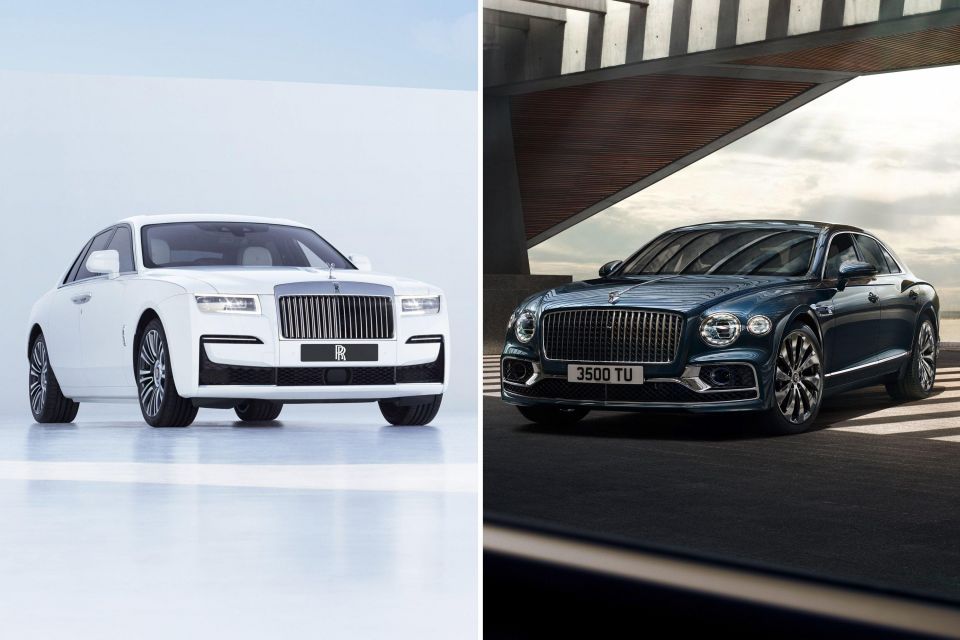

Design Contributor
The most fierce battle at the top-end of the luxury limousine world took place some years ago between the resurrected Rolls-Royce Phantom and Bentley Mulsanne. Two opulent vehicles with a shared past, built as direct competitors from German-owned British companies. What more could you want?
Time passed and Bentley decided to retreat from the flagship luxury sedan segment, leaving Rolls-Royce alone with the latest generation of the Phantom.
However, the discontinuation of Bentley’s flagship brought another interesting change: the smaller Continental Flying Spur grew larger and more luxurious in its third iteration, aiming to grasp a portion of Mulsanne buyers alongside the more popular Bentayga SUV.
At Rolls-Royce, it was time to make an equally impressive move in order to keep this battle fair. The solution? A new Ghost, replacing its 10-year-old predecessor
The rivalry between the all-new Rolls-Royce Ghost and the Bentley Continental Flying Spur is the subject of our Design Battle.
The Ghost premiered in September 2020 as the new entry-level limousine in the Rolls-Royce range.
Unlike its predecessor, which shared most of its underpinnings with the BMW 7 Series, the new Ghost is built on a fully aluminium platform just like the larger Phantom and Cullinan models, featuring aluminium body panels.
Engine: 6.75-litre V12 turbocharged engine producing 420kW and 850Nm Transmission: Eight-speed torque converter automatic 0-100km/h: 4.6 seconds Dimensions: 5546mm long, 1978mm wide, 1571mm tall, 3295mm wheelbase Weight: 2553kg
The third generation of the Continental Flying Spur premiered in September 2019 as a luxury four-door Grand Tourer combining “sports sedan agility and modern limousine refinement”.
It is built on a brand new steel and aluminium monocoque chassis with aluminium body panels, with the goal of replacing both its predecessor and indirectly the discontinued Mulsanne as Bentley’s new flagship sedan.
Engine: 6.0-litre W12 turbocharged engine producing 467kW and 900Nm Transmission: Eight-speed dual-clutch automatic 0-100km/h: 3.7 seconds Dimensions: 5316mm long, 1978mm wide, 1484mm tall, 3194mm wheelbase Weight: 2437kg

Rolls-Royce Ghost
The designers at Rolls-Royce have chosen an evolutionary and minimalist approach for the aesthetics of the new Ghost, called ‘Post Opulence’. At the front, the LED headlights are more angular than before while the classic Rolls-Royce grille is illuminated for the first time.
The single intake at the lower part of the bumper optically enhances the width of the car, which is 30 mm wider compared to its predecessor and gives it a floating face. As with every Rolls-Royce, the Spirit of Ecstacy emblem sits at the edge of the long bonnet, safely retracting when the car is parked or in danger of a collision
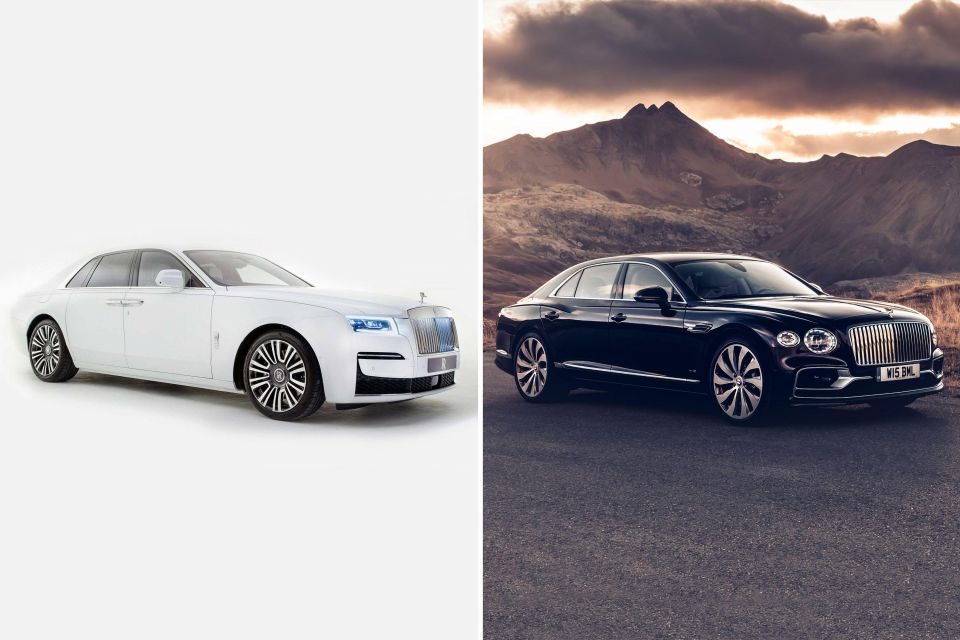
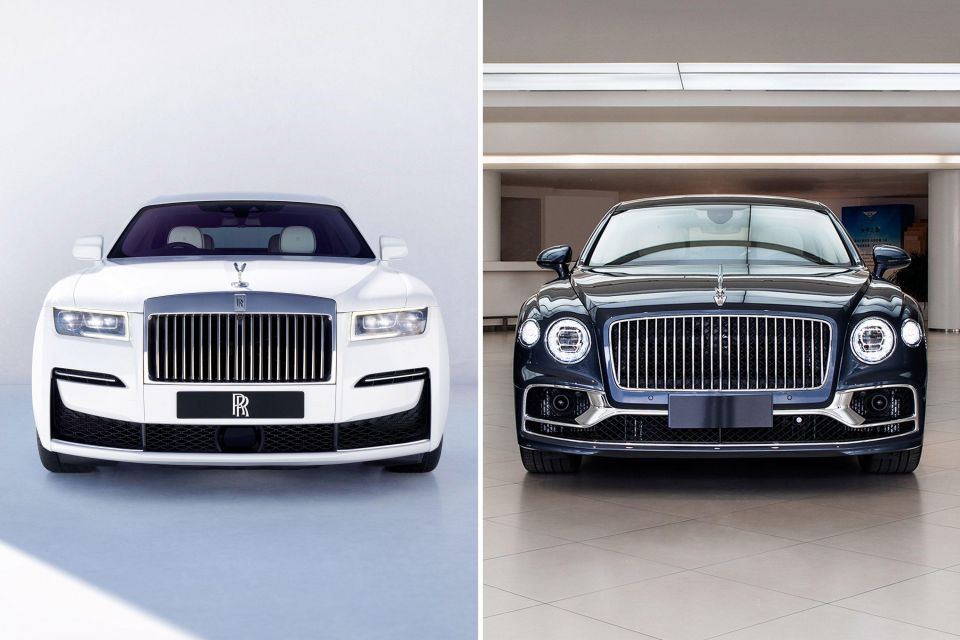
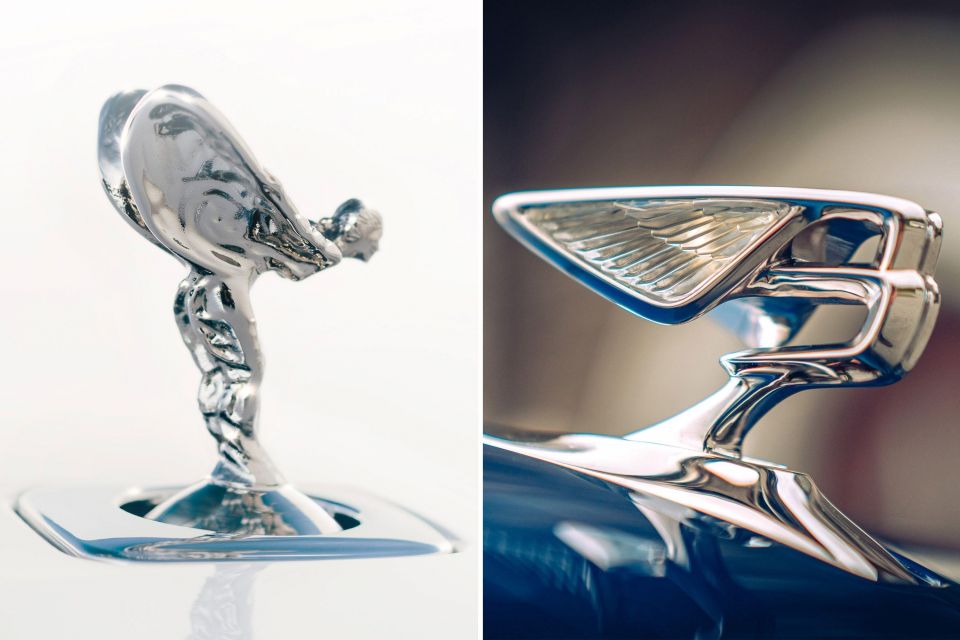
Bentley Continental Flying Spur
The Continental Flying Spur has a more luxurious design than its predecessors, borrowing cues from the outgoing Mulsanne. The four LED matrix headlights feature cut-crystal effect graphics, just like in the Continental GT.
Between them, the large rectangular grille reaches lower at the front bumper, surrounded by the sculpted air intakes which are divided by an aerodynamic wing. Last but not least, the recently-restyled Flying B emblem at the edge of the long bonnet is retractable and features illuminated wings.
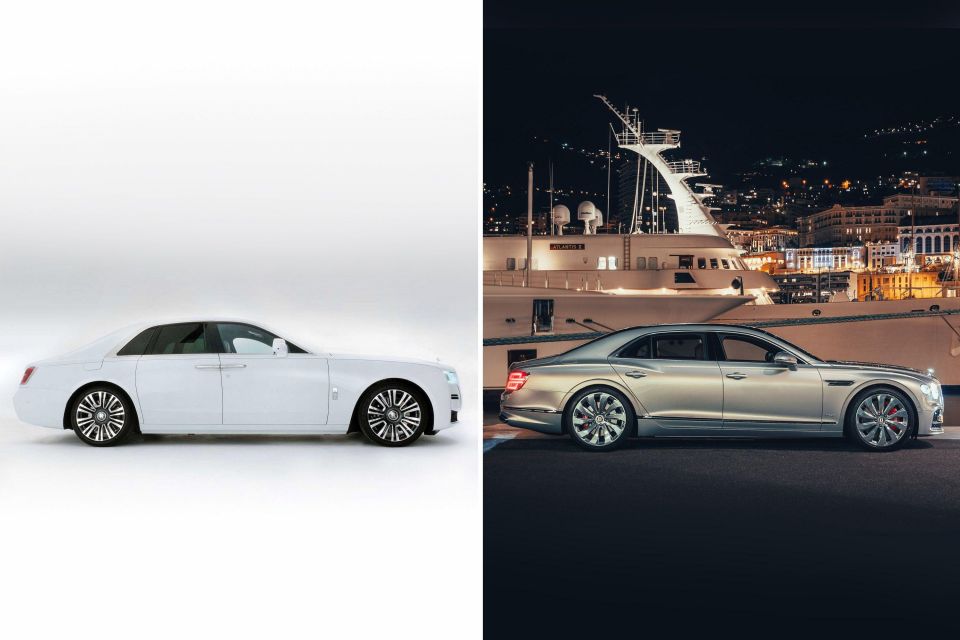
Rolls-Royce Ghost
From the side, the Ghost features classic limousine proportions and the body looks like it is made from a single volume due to the lack of shut lines. The suicide doors have an almost symmetrical shape symbolising that this car can be both driver-oriented and chauffeur-driven.
For ease of use they open and close electronically. The main character line is nearly horizontal, running from the headlights to the slightly dropping tail, emphasising the car’s length. Below is another dynamic line inspired by boats.
The glasshouse shape is typical of Rolls-Royce, framed by thick aluminium at the strong D-pillar. In terms of exterior colours, the personalisation options are virtually countless and are only restricted by the imagination of the customer.
Bentley Continental Flying Spur
The profile is probably the strongest view of the Continental Flying Spur thanks to the muscular lines above the front and rear fenders that are unique to this model.
The bonnet is long (though shorter than the Mulsanne’s), the glasshouse and the wheelbase look massive (130mm longer than its predecessor), while there is a contrast between the minimal front overhang and the long tail. The insert above the side sills is rising towards the back, continuing in the rear bumper, and the 21- or even 22-inch wheels further enhance the athletic look.
Bentley offers a selection of 17 paint options for the exterior (plus more bespoke shades) that can be combined with Blackline specification for a sportier look.

Rolls-Royce Ghost
The rear view of the Ghost is characterised by a long rear volume with an inclined rear windscreen, and a forward tilt to the tail. The LED taillights have a more fluid shape and a softer appearance than any other Rolls-Royce model.
The chrome-decorated licence plate sits at the middle of the rear trunk hiding a 507-litre luggage space. The rear bumper follows the same subtle approach with minimal panel gaps and dual elongated tailpipes at the bottom.

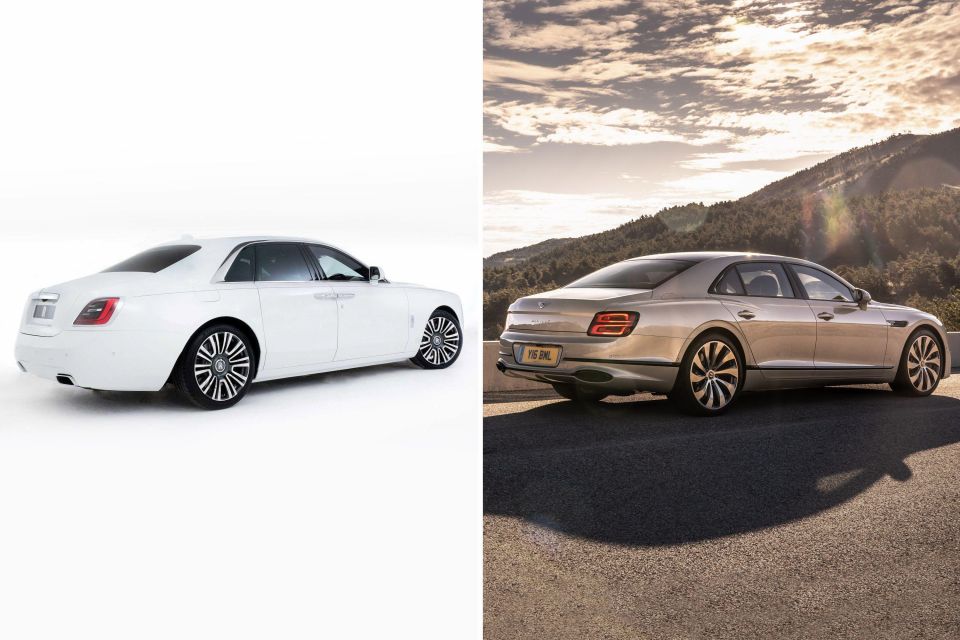
Bentley Continental Flying Spur
The third generation of the Continental Flying Spur is more muscular and aggressive than ever before. The pronounced rear shoulders fade to rounded rectangular taillights with B-shaped LED graphics.
The boot lid for the 420-litre luggage space has strong dynamic lines exuding power. The rear bumper housing the licence plate is divided by a decorative chrome or dark-chrome strip continuing the profile theme. Below, the dual oval tailpipes – a sign of Bentley’s W12 – are connected through a horizontal insert above the body-coloured diffuser.
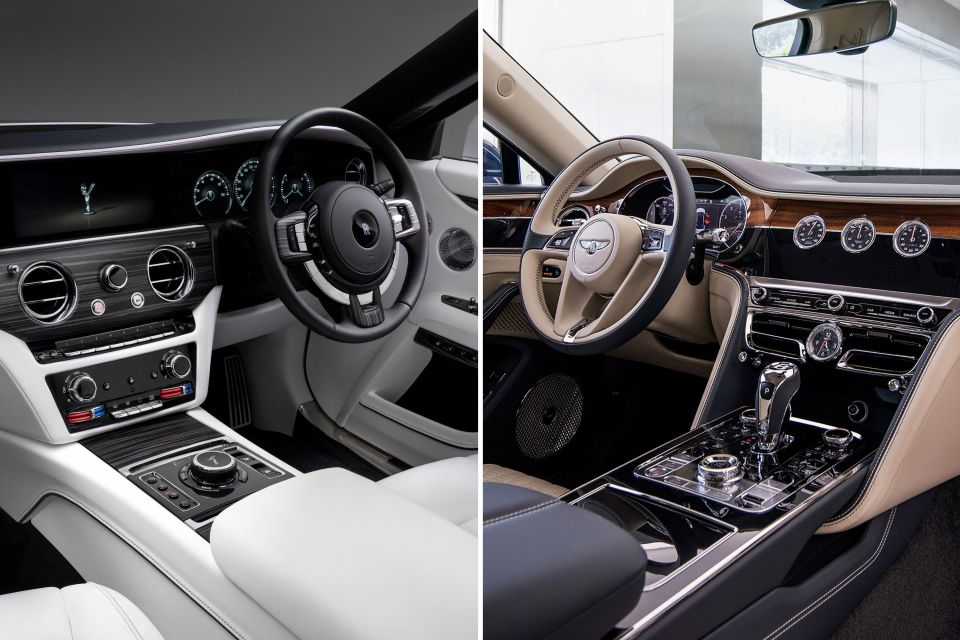
Rolls-Royce Ghost
The new Ghost brings an even more upmarket feel to its interior, with simple and large volumes, high-quality materials, and great attention to detail. The highlight is the illuminated Ghost nameplate on the passenger side of the dashboard, surrounded by more than 850 illuminated stars (invisible when the car is not in use) echoing the signature Starlight Headliner.
A digital screen sits at the top of the dashboard above the round-shaped retro climate vents. At the bottom part of the upright central console there are physical knobs for the four-zone climate controls, and on the central tunnel is a rotating dial for the infotainment. Behind the large steering wheel – typical of Rolls-Royce – we find a fully-digital instrument cluster with analogue-style graphics.
Rolls-Royce is very proud of the acoustics of the interior, adding more than 100kg of insulation. Furthermore, each component inside the cabin was specifically tuned to resonate in the same frequency, creating a subtle whisper while driving instead of a disorienting total silence.
The bespoke 1300W audio system with 18 channels and 18 speakers utilises the car’s chamber as a subwoofer while two active microphones provide active noise cancelling.
As with every car coming from the Rolls-Royce factory, there are countless personalisation options and many different trims for the interior, with the Obsidian Ayous (inspired by the colours found in lava rock) and the Dark Amber (dark wood with integrated veins of aluminium particles) finishes developed exclusively for the Ghost.
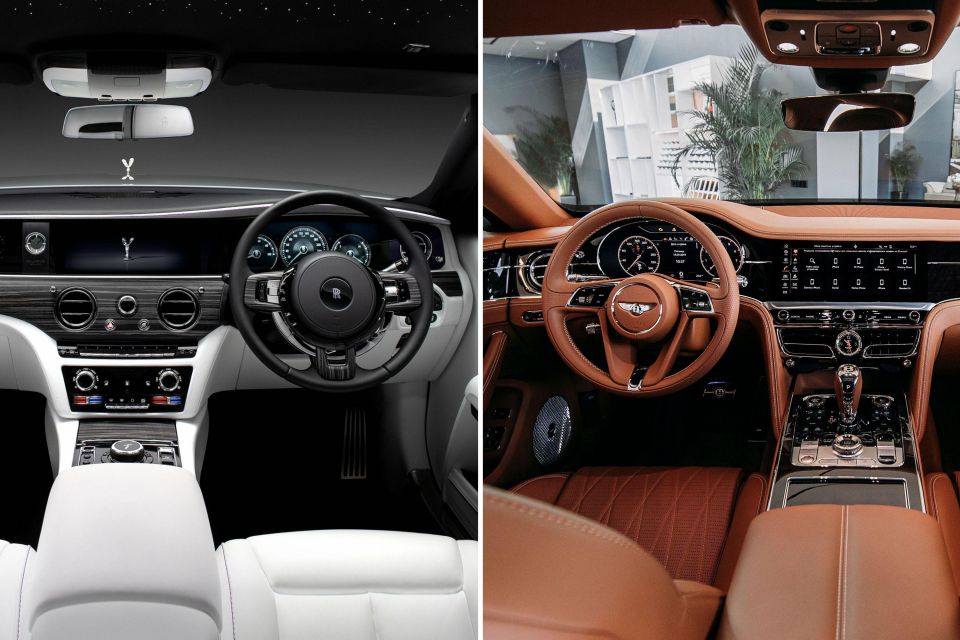
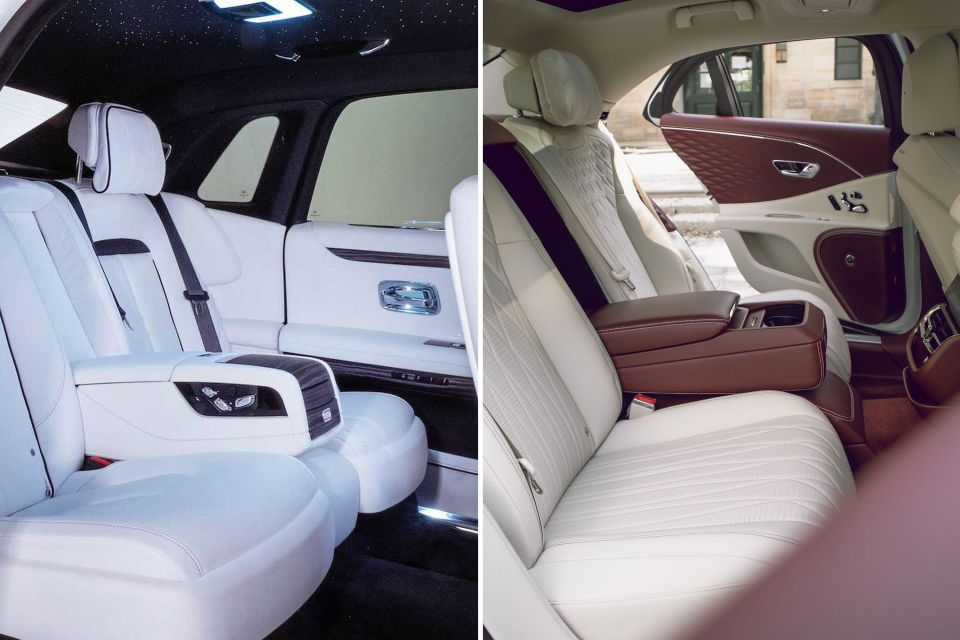
Bentley Continental Flying Spur
The interior of a Bentley cannot be mistaken for any other luxury carmaker, offering a combination of expensive materials (leather, aluminium and hand-crafted veneers), numerous personalisation options, and the latest technology. The latter can be hidden, as the 12.3-inch central touchscreen gives way to three analogue dials or a veneer thanks to the clever Bentley Rotating Display.
Behind the leather-wrapped steering wheel is a digital instrument cluster. Just like in the Continental GT, the dashboard expands into the door inserts for a homogenous look – but in the Flying Spur’s case the climate vents in each side of the analogue clock on the central console have a distinctive shape. There is also ambient lighting configurable in seven different colours.
The rear seats offer 14-way adjustment and five massaging modes, while rear passengers have access to large tablets for their entertainment as well as the Touch Screen Remote.
For the audiophiles, Bentley offers a choice of three audio systems – the top of the range is the Naim with an output of 2200W, a 21-channel amplifier, 18 illuminated speakers, two active bass transducers and 8 sound modes.
As you can imagine, Bentley offers bespoke personalisation options in close to infinite combinations, with the help of Mulliner, according to the preferences of each customer. For example you can have things like monogrammed upholstery on the seats, or solid wood, three-dimensional quilted door inserts from open-pore walnut.
Which one would you prefer?Created with PollMaker

Max Davies
15 Hours Ago


William Stopford
15 Hours Ago


Derek Fung
16 Hours Ago


Max Davies
23 Hours Ago


William Stopford
2 Days Ago


Ben Zachariah
2 Days Ago